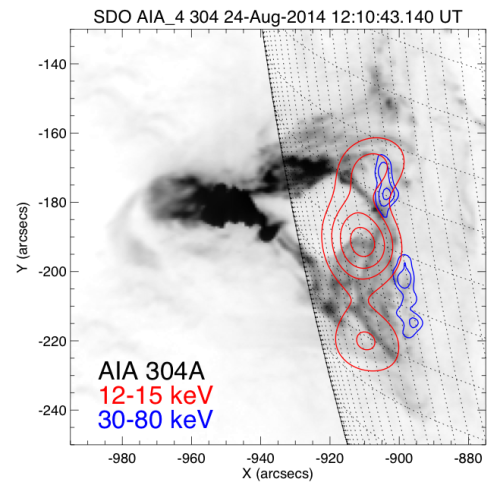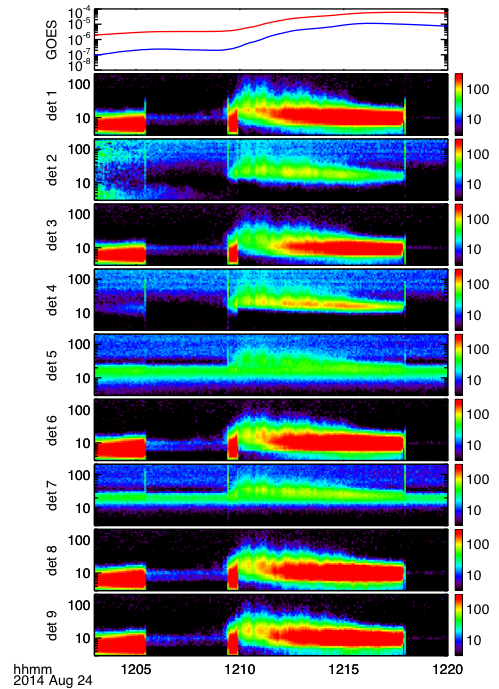RHESSI Resumes Observations
| Nugget | |
|---|---|
| Number: | 234 |
| 1st Author: | Albert Shih |
| 2nd Author: | Säm Krucker |
| Published: | September 1, 2014 |
| Next Nugget: | Which RHESSI Detectors? |
| Previous Nugget: | Evidence for Nanoflare Heating |
Introduction
As announced in an earlier Nugget, RHESSI entered its fourth annealing in late June. This process is periodically necessary to rejuvenate the detectors from the effects of the radiation damage that accumulates gradually in orbit, and a still earlier Nugget explains the process in further detail.
We are happy now that the process is complete, and that RHESSI is functioning again in a satisfactory, although (as expected) not quite as well as in 2002!
Detectors
Of RHESSI's nine detectors, each of which can make images, we now have five (1, 3, 6, 8, and 9) that are segmented, meaning that they can operate simultaneously as X-ray and gamma-ray detectors. In this configuration, the front segments can observe both hard X-rays and soft X-rays (down to ~3 keV). The anneal has successfully restored the spectral resolution (~1 keV FWHM at X-ray energies) and the X-ray sensitivity of these five detectors. For X-ray spectroscopy, you would use one or more of these detectors.
The anneal did in fact also rejuvenate the other four detectors (2, 4, 5, and 7), but because they currently do not electronically segment, they have relatively worse spectral resolution and can only measure above ~20 keV. Even with these limitations, these detectors are still quite usable for the core of RHESSI science: hard X-ray imaging spectroscopy. In the future, as radiation damage accrues again in these detectors, it may actually become possible for a couple of them to operate segmented again.
Thus, the anneal has achieved goals (see below for examples of recent data), albeit with some loss of image quality at soft X-ray energies since only a subset of the detectors can be used. At this stage in RHESSI's precious life – anticipating a few more powerful flares in this cycle – we are happy to have the higher spectral resolution that the annealing allowed.
Imaging
In Figure 1 we show an image of SOL2014-08-24T12, an almost-X-class event that had interesting structures. The Figure shows that RHESSI can image, at high resolution, the hard X-ray footpoint sources, as well as capturing the soft X-ray coronal loop structure at high temperatures.
Note the interesting difference between RHESSI's soft X-ray contours and the AIA structures: RHESSI is showing us a better representation of the energetically important loop structures, which differ substantially from the EUV appearance.
Spectroscopy
How well can RHESSI now do imaging spectroscopy? There is essentially no change as a result of the anneal above 20 keV, as Figure 2 shows. This is an example (one example for each RHESSI detector) of the spectrogram representation of the RHESSI data.
Conclusion
RHESSI is now back in business after its fourth anneal, which we deem to have been a great success. For the immediate future (hoping for X-class flares!) the use of RHESSI for high-resolution imaging spectroscopy in the hard X-ray range, and down to thermal energies, can proceed as before. As always, for careful work it is important to work with the individual detectors. For spectroscopy below ~20 keV, only use detectors 1, 3, 6, 8, and 9 for the moment. This list of segmented detectors is subject to possible future improvements, which we'll also announce in a Nugget.

